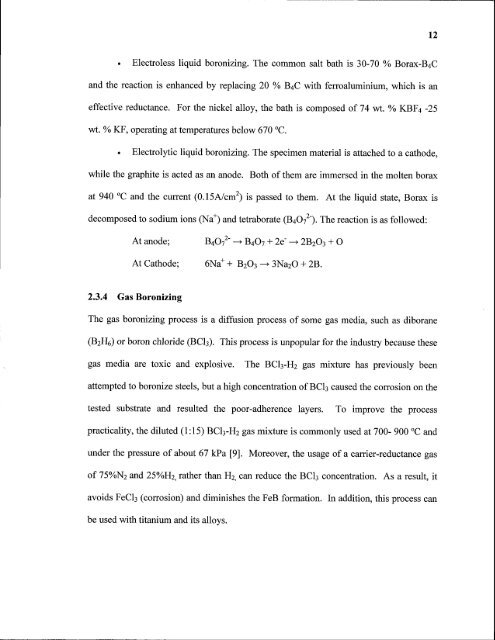Multi-component boron coatings on low carbon steel AISI 1018
Multi-component boron coatings on low carbon steel AISI 1018
Multi-component boron coatings on low carbon steel AISI 1018
Create successful ePaper yourself
Turn your PDF publications into a flip-book with our unique Google optimized e-Paper software.
12<br />
• Electroless liquid <str<strong>on</strong>g>bor<strong>on</strong></str<strong>on</strong>g>izing. The comm<strong>on</strong> salt bath is 30-70 % Borax-B 4C<br />
and the reacti<strong>on</strong> is enhanced by replacing 20 % B 4C with ferroaluminium, which is an<br />
effective reductance. For the nickel alloy, the bath is composed of 74 wt. % KBF4 -25<br />
wt. % KF, operating at temperatures be<strong>low</strong> 670 °C.<br />
• Electrolytic liquid <str<strong>on</strong>g>bor<strong>on</strong></str<strong>on</strong>g>izing. The specimen material is attached to a cathode,<br />
while the graphite is acted as an anode. Both of them are immersed in the molten borax<br />
at 940 °C and the current (0.15A/cm) is passed to them. At the liquid state, Borax is<br />
decomposed to sodium i<strong>on</strong>s (Na+) and tetraborate (B40 72). The reacti<strong>on</strong> is as fol<strong>low</strong>ed:<br />
At anode; B4072- —> B407 + 2e - —> 2B203 + 0<br />
At Cathode; 6Na+ + B 203 —> 3Na2O + 2B.<br />
2.3.4 Gas Bor<strong>on</strong>izing<br />
The gas <str<strong>on</strong>g>bor<strong>on</strong></str<strong>on</strong>g>izing process is a diffusi<strong>on</strong> process of some gas media, such as diborane<br />
(B2H6) or <str<strong>on</strong>g>bor<strong>on</strong></str<strong>on</strong>g> chloride (BCI 3). This process is unpopular for the industry because these<br />
gas media are toxic and explosive. The BCI3-H2 gas mixture has previously been<br />
attempted to <str<strong>on</strong>g>bor<strong>on</strong></str<strong>on</strong>g>ize <strong>steel</strong>s, but a high c<strong>on</strong>centrati<strong>on</strong> of BCI3 caused the corrosi<strong>on</strong> <strong>on</strong> the<br />
tested substrate and resulted the poor-adherence layers. To improve the process<br />
practicality, the diluted (1:15) BCI3-H2 gas mixture is comm<strong>on</strong>ly used at 700- 900 °C and<br />
under the pressure of about 67 kPa [9]. Moreover, the usage of a carrier-reductance gas<br />
of 75%N2 and 25%H 2, rather than H2, can reduce the BCI 3 c<strong>on</strong>centrati<strong>on</strong>. As a result, it<br />
avoids FeCl3 (corrosi<strong>on</strong>) and diminishes the FeB formati<strong>on</strong>. In additi<strong>on</strong>, this process can<br />
be used with titanium and its alloys.
















